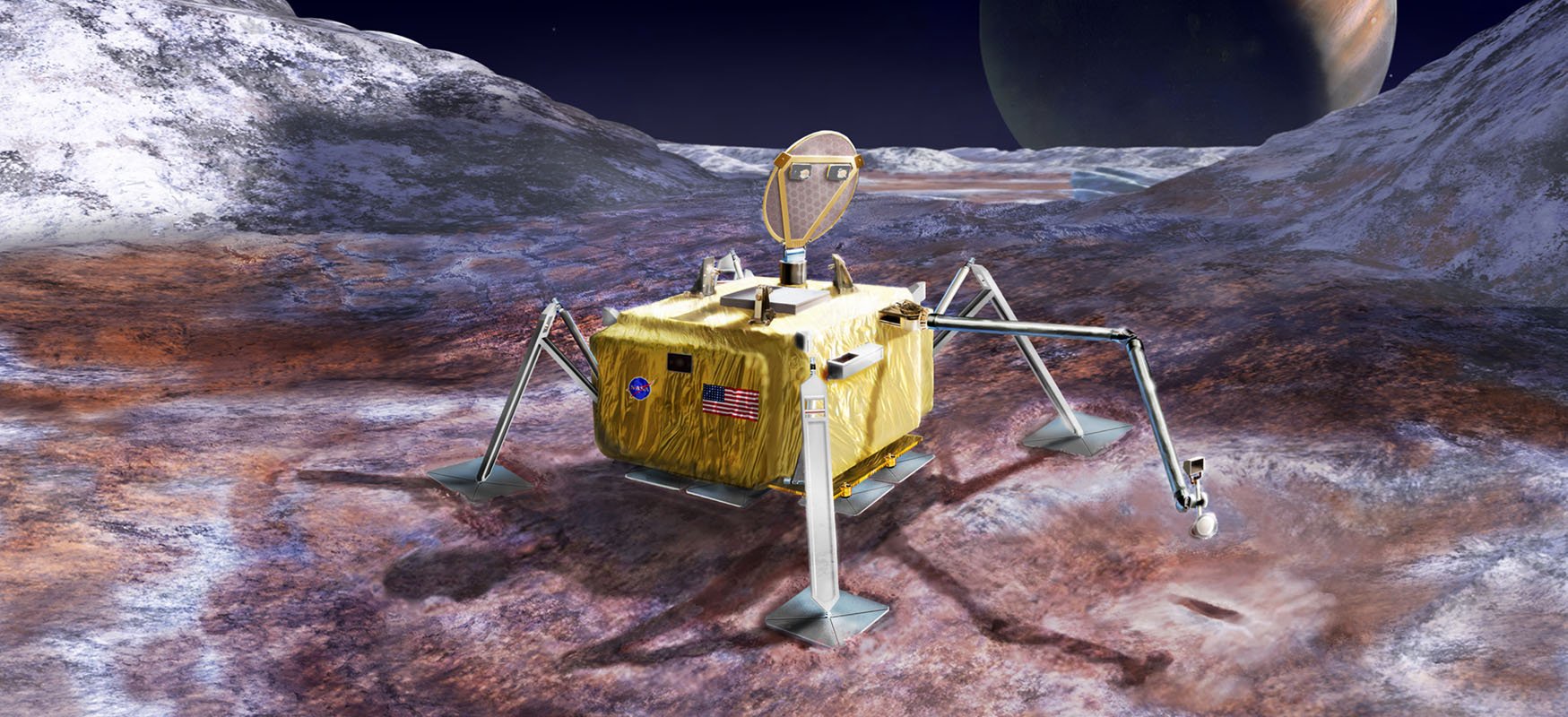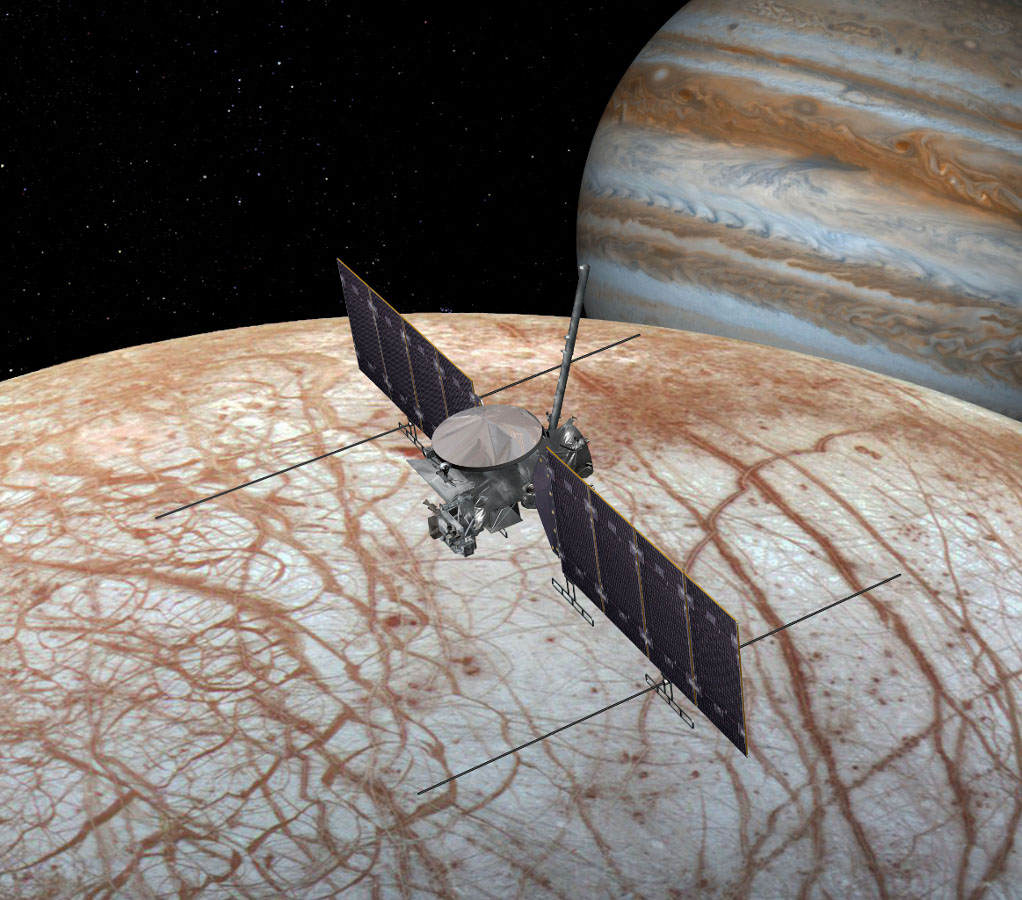Find out the latest thinking about our universe.
-
bystander
- Apathetic Retiree
- Posts: 21577
- Joined: Mon Aug 28, 2006 2:06 pm
- Location: Oklahoma
Post
by bystander » Thu Feb 09, 2017 4:11 pm
NASA Receives Science Report on Europa Lander Concept
NASA | JPL-Caltech | 2017 Feb 09
A report on the potential science value of a lander on the surface of Jupiter's icy moon Europa has been delivered to NASA, and the agency is now engaging the broader science community to open a discussion about its findings.
In early 2016, in response to a congressional directive, NASA's Planetary Science Division began a pre-Phase A study to assess the science value and engineering design of a future Europa lander mission. NASA routinely conducts such studies -- known as Science Definition Team (SDT) reports -- long before the beginning of any mission to gain an understanding of the challenges, feasibility and science value of the potential mission. In June 2016, NASA convened a 21-member team of scientists for the SDT. Since then, the team has deliberated to define a workable and worthy set of science objectives and measurements for the mission concept, submitting a report to NASA on Feb. 7.
The report lists three science goals for the mission. The primary goal is to search for evidence of life on Europa. The other goals are to assess the habitability of Europa by directly analyzing material from the surface, and to characterize the surface and subsurface to support future robotic exploration of Europa and its ocean. The report also describes some of the notional instruments that could be expected to perform measurements in support of these goals. ...
Know the quiet place within your heart and touch the rainbow of possibility; be
alive to the gentle breeze of communication, and please stop being such a jerk. — Garrison Keillor
-
bystander
- Apathetic Retiree
- Posts: 21577
- Joined: Mon Aug 28, 2006 2:06 pm
- Location: Oklahoma
Post
by bystander » Wed Feb 22, 2017 2:53 am
Europa Flyby Mission Moves into Design Phase
NASA |
JPL-Caltech | Mission to Europa | 2017 Feb 21
A mission to examine the habitability of Jupiter's ocean-bearing moon Europa is taking one step closer to the launchpad, with the recent completion of a major NASA review.
On Feb. 15,
NASA's Europa multiple-flyby mission successfully completed its Key Decision Point-B review. This NASA decision permits the mission to move forward into its preliminary design phase, known as "Phase B," beginning on Feb. 27.
A highlight of Phase A was the selection and accommodation of 10 instruments being developed to study the scientific mysteries of Europa. The new mission phase is planned to continue through September 2018, and will result in the completion of a preliminary design for the mission's systems and subsystems. Some testing of spacecraft components, including solar cells and science instrument detectors, has already been underway during Phase A, and this work is planned to continue into Phase B.
In addition, during Phase B subsystem vendors will be selected, as well as prototype hardware elements for the science instruments. Spacecraft subassemblies will be built and tested as well.
The Europa mission spacecraft is being planned for launch in the 2020s, arriving in the Jupiter system after a journey of several years. The spacecraft would orbit Jupiter as frequently as every two weeks, providing many opportunities for close flybys of Europa. The mission plan includes 40 to 45 flybys in the prime mission, during which the spacecraft would image the moon's icy surface at high resolution and investigate its composition and the structure of its interior and icy shell. ...
Know the quiet place within your heart and touch the rainbow of possibility; be
alive to the gentle breeze of communication, and please stop being such a jerk. — Garrison Keillor
-
bystander
- Apathetic Retiree
- Posts: 21577
- Joined: Mon Aug 28, 2006 2:06 pm
- Location: Oklahoma
Post
by bystander » Fri Mar 10, 2017 3:44 pm
NASA Mission Named 'Europa Clipper'
NASA |
JPL-Caltech | Europa Clipper | 2017 Mar 09
NASA's upcoming mission to investigate the habitability of Jupiter's icy moon Europa now has a formal name:
Europa Clipper.
The moniker harkens back to the clipper ships that sailed across the oceans of Earth in the 19th century. Clipper ships were streamlined, three-masted sailing vessels renowned for their grace and swiftness. These ships rapidly shuttled tea and other goods back and forth across the Atlantic Ocean and around the globe.
In the grand tradition of these classic ships, the Europa Clipper spacecraft would sail past Europa at a rapid cadence, as frequently as every two weeks, providing many opportunities to investigate the moon up close. The prime mission plan includes 40 to 45 flybys, during which the spacecraft would image the moon's icy surface at high resolution and investigate its composition and the structure of its interior and icy shell.
Europa has long been a high priority for exploration because it holds a salty liquid water ocean beneath its icy crust. The ultimate aim of Europa Clipper is to determine if Europa is habitable, possessing all three of the ingredients necessary for life: liquid water, chemical ingredients, and energy sources sufficient to enable biology. ...
Know the quiet place within your heart and touch the rainbow of possibility; be
alive to the gentle breeze of communication, and please stop being such a jerk. — Garrison Keillor
-
bystander
- Apathetic Retiree
- Posts: 21577
- Joined: Mon Aug 28, 2006 2:06 pm
- Location: Oklahoma
Post
by bystander » Tue Aug 20, 2019 3:25 pm
Mission to Jupiter's Icy Moon Confirmed
NASA |
JPL-Caltech |
Europa Clipper | 2019 Aug 19
An icy ocean world in our solar system that could tell us more about the potential for life on other worlds is coming into focus with confirmation of the
Europa Clipper mission’s next phase. The decision allows the mission to progress to completion of final design, followed by the construction and testing of the entire spacecraft and science payload.
“We are all excited about the decision that moves the Europa Clipper mission one key step closer to unlocking the mysteries of this ocean world,” said Thomas Zurbuchen, associate administrator for the Science Mission Directorate at NASA Headquarters in Washington. “We are building upon the scientific insights received from the flagship Galileo and Cassini spacecraft and working to advance our understanding of our cosmic origin, and even life elsewhere.”
The mission will conduct an in-depth exploration of Jupiter's moon, Europa, and investigate whether the icy moon could harbor conditions suitable for life, honing our insights into astrobiology. To develop this mission in the most cost-effective fashion, NASA is targeting to have the Europa Clipper spacecraft complete and ready for launch as early as 2023. The agency baseline commitment, however, supports a launch readiness date by 2025.
Know the quiet place within your heart and touch the rainbow of possibility; be
alive to the gentle breeze of communication, and please stop being such a jerk. — Garrison Keillor
-
bystander
- Apathetic Retiree
- Posts: 21577
- Joined: Mon Aug 28, 2006 2:06 pm
- Location: Oklahoma
Post
by bystander » Tue Aug 20, 2019 5:09 pm
Europa Clipper Mission Overview
NASA | JPL-Caltech | Europa Clipper
NASA's Europa Clipper mission will conduct detailed reconnaissance of Jupiter's moon Europa to see whether the icy moon could harbor conditions suitable for life. The mission will carry a highly capable, radiation-tolerant spacecraft that will perform repeated close flybys of the icy moon from a long, looping orbit around Jupiter.
The payload of selected science instruments includes cameras and spectrometers to produce high-resolution images of Europa's surface and determine its composition. An ice penetrating radar will determine the thickness of the moon's icy shell and search for subsurface lakes similar to those beneath Antarctica. The mission also will carry a magnetometer to measure strength and direction of the moon's magnetic field, whichwill allow scientists to determine the depth and salinity of its ocean.
A thermal instrument will scour Europa's frozen surface in search of recent eruptions of warmer water, while additional instruments will search for evidence of water and tiny particles in the moon's thin atmosphere. NASA's Hubble Space Telescope observed water vapor above the south polar region of Europa in 2012, providing the first strong evidence of water plumes. If the plumes' existence is confirmed - and they're linked to a subsurface ocean - it will help scientists investigate the chemical makeup of Europa's potentially habitable environment while minimizing the need to drill through layers of ice.
- Plasma Instrument for Magnetic Sounding (PIMS) -- principal investigator Dr. Joseph Westlake of Johns Hopkins Applied Physics Laboratory (APL), Laurel, Maryland. This instrument works in conjunction with a magnetometer and is key to determining Europa's ice shell thickness, ocean depth, and salinity by correcting the magnetic induction signal for plasma currents around Europa.
- Mapping Imaging Spectrometer for Europa (MISE) -- principal investigator Dr. Diana Blaney of JPL. This instrument will probe the composition of Europa, identifying and mapping the distributions of organics, salts, acid hydrates, water ice phases, and other materials to determine the habitability of Europa's ocean.
- Europa Imaging System (EIS) -- principal investigator Dr. Elizabeth Turtle of APL. The wide and narrow angle cameras on this instrument will map most of Europa at 50 meter (164 foot) resolution, and willprovide images of areas of Europa's surface at up to 100 times higher resolution.
- Radar for Europa Assessment and Sounding: Ocean to Near-surface (REASON) -- principal investigator Dr. Donald Blankenship of the University of Texas, Austin. This dual-frequency ice penetrating radar instrument is designed to characterize and sound Europa's icy crust from the near-surface to the ocean, revealing the hidden structure of Europa's ice shell and potential water within.
- Europa Thermal EMission Imaging System (E-THEMIS) -- principal investigator Dr. Philip Christensen of Arizona State University, Tempe. This "heat detector" will provide high spatial resolution, multi-spectral thermal imaging of Europa to help detect active sites, such as potential vents erupting plumes of water into space.
- MAss SPectrometer for Planetary EXploration/Europa (MASPEX) -- principal investigator Dr. Jack (Hunter) Waite of the Southwest Research Institute (SwRI), San Antonio. This instrument will determine the composition of the surface and subsurface ocean by measuring Europa's extremely tenuous atmosphere and any surface material ejected into space.
- UltraViolet Spectrograph/Europa (UVS) -- principal investigator Dr. Kurt Retherford of SwRI. This instrument will adopt the same technique used by the Hubble Space Telescope to detect the likely presence of water plumes erupting from Europa's surface. UVS will be able to detect small plumes and will provide valuable data about the composition and dynamics of the moon's rarefied atmosphere.
- SUrface Dust Mass Analyzer (SUDA) -- principal investigator Dr. Sascha Kempf of the University of Colorado, Boulder. This instrument will measure the composition of small, solid particles ejected from Europa, providing the opportunity to directly sample the surface and potential plumes on low-altitude flybys.
- Magnetometer -- A magnetometer will be useful for observing Europa’s magnetic field, helping scientists confirm the existence of Europa’s ocean, as well as determine its salinity and depth. The instrument will also constrain the thickness of the ice shell. Understanding both the ocean’s properties and the thickness of the ice crust on top of it is essential to figuring out whether Europa could be habitable, the key science goal of the mission.
Know the quiet place within your heart and touch the rainbow of possibility; be
alive to the gentle breeze of communication, and please stop being such a jerk. — Garrison Keillor

